Gulls: A Who's Who
By Gord Gadsden
The Fraser Valley has eight species of gull that are regularly seen mostly during the fall, winter and 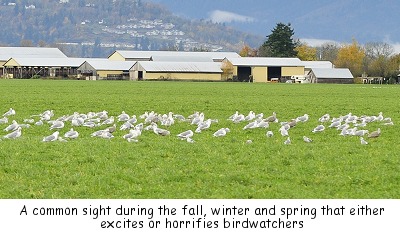 spring. This group of birds can pose significant identification challenges. I'm being generous with that statement. A field of 1000 gulls scampering about looking for worms can make one look the other way until they are past. The opinion is often that there are indeed gulls out there, but it consists of just one species; Seagull. But then, a flock of 1000 gulls to some is a delightful challenge that always holds a hint that something neat might be discovered within the flock. I belong to the latter where I find it interesting to see what kinds are out there and what ones are identifiable. Discovering a neat species of gull from Asia is always a bonus. Sometimes, when I'm counting for a Christmas Bird Count or keeping records, 'Seagull' does not cut it. However, I did not always feel this way just because it seemed very overwhelming. I'm hoping to share some insights that might generate more interest. Once you start to figure these guys out, there's no turning back and it does actually get easier. It's the getting started part which is the hill to climb, so don't give up and take up golfing quite yet! spring. This group of birds can pose significant identification challenges. I'm being generous with that statement. A field of 1000 gulls scampering about looking for worms can make one look the other way until they are past. The opinion is often that there are indeed gulls out there, but it consists of just one species; Seagull. But then, a flock of 1000 gulls to some is a delightful challenge that always holds a hint that something neat might be discovered within the flock. I belong to the latter where I find it interesting to see what kinds are out there and what ones are identifiable. Discovering a neat species of gull from Asia is always a bonus. Sometimes, when I'm counting for a Christmas Bird Count or keeping records, 'Seagull' does not cut it. However, I did not always feel this way just because it seemed very overwhelming. I'm hoping to share some insights that might generate more interest. Once you start to figure these guys out, there's no turning back and it does actually get easier. It's the getting started part which is the hill to climb, so don't give up and take up golfing quite yet!
Gulls enjoy each other's company so they are often found in a flock. This is good for learning gulls because in a large flock, there are plenty of individuals to discard if they are challenging to ID at the moment. This should, ideally, still leave ones suitable to learn on. When I approach a flock of gulls, I scan it over first to see if anything jumps out. Often, the interesting ones are quite dark-backed compared to the sea of varying degrees of light grey which our common gulls' backs are coloured. Likewise, a very light coloured or small individual also demands attention for a closer look. If nothing grabs attention, it's time to settle in for a closer scrutiny. For the purposes of this article, I will only discuss adult birds. Most gulls take four years to reach their adult colours. Each year demands a different looking bird. On top of that, variance among individuals runs rampant. Depending on molt and feather wear, well, this only adds to the fun. I will not put much detail into describing all of each species' field marks in this article either. This is in the interest of keeping this article small. Referring to a field guide will be useful as you go along. One will also notice the words such as "mostly", "sometimes", "typically", "usually" and "in general" among others in frequent use throughout this article. This is a necessity which will become better understood the more one looks at gulls. If one can handle the vagueness found in 'gulling' then one could also likely do well in politics or selling used cars.
Big vs. Small
Generally speaking, gulls come in two groups; big ones and small ones. This is a good starting point.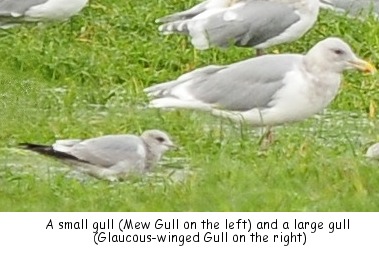 If the gull you are looking at is small (about crow-size), you're in luck already as it's likely down between two species. What is not so lucky is that these two, Ring-billed and Mew Gull, both have black wing-tips and yellow legs. However, Mew Gulls, the smaller of the two, are daintier looking and almost suggest a pigeon in facial appearance and walking style. A Mew Gull's dark eye also lends for a pigeon-like gentle expression. Ring-billed Gulls are a tad larger and have more of a fierce look due to a yellow eye. Wing-tip pattern also differs and of course, the markings on the bill. Keep in mind some Mew Gulls can have a hint of a black ring on the bill but it is faint and narrow. These two gull species display adult plumage in two years. If the gull you are looking at is small (about crow-size), you're in luck already as it's likely down between two species. What is not so lucky is that these two, Ring-billed and Mew Gull, both have black wing-tips and yellow legs. However, Mew Gulls, the smaller of the two, are daintier looking and almost suggest a pigeon in facial appearance and walking style. A Mew Gull's dark eye also lends for a pigeon-like gentle expression. Ring-billed Gulls are a tad larger and have more of a fierce look due to a yellow eye. Wing-tip pattern also differs and of course, the markings on the bill. Keep in mind some Mew Gulls can have a hint of a black ring on the bill but it is faint and narrow. These two gull species display adult plumage in two years.
Big Gulls
Here is where it gets a little bit trickier. First, It is a good idea to become accustomed to the most  common large gull in our region; the Glaucous-winged Gull. This large bodied, dark-eyed gull is found everywhere and typically, including their hybrids, accounts for at least 95% of the flocks of gulls in most situations. It should be noted that hybridization runs rampant among gulls, especially involving the Glaucous-winged Gull. This should comfort us as we struggle to indentify gulls. Apparently, they themselves sometimes can't tell either. Hybrids with Western Gull are most common, and these hybrids often outnumber pure Glaucous-winged Gulls in a flock. Hybridization with Herring Gulls appears to be the second most common hybrid found in our area. A pure Glaucous-winged Gull is fairly straight forward. Its wingtips are about the same grey colour as their backs. The challenge lies when the Glaucous-winged Gull hybridizes with a gull species that has black wing tips. The result is a gull often mistaken for Herring or Thayer's Gulls. A hybrid that back-crosses with a Western Gull often results in a darker backed individual with dark wingtips that is suggestive of a Western Gull or, to the over eager, a Slaty-backed Gull. Hybrids with Herring Gulls results in a grey backed individual but with darker grey, (but typically not black) wingtips. common large gull in our region; the Glaucous-winged Gull. This large bodied, dark-eyed gull is found everywhere and typically, including their hybrids, accounts for at least 95% of the flocks of gulls in most situations. It should be noted that hybridization runs rampant among gulls, especially involving the Glaucous-winged Gull. This should comfort us as we struggle to indentify gulls. Apparently, they themselves sometimes can't tell either. Hybrids with Western Gull are most common, and these hybrids often outnumber pure Glaucous-winged Gulls in a flock. Hybridization with Herring Gulls appears to be the second most common hybrid found in our area. A pure Glaucous-winged Gull is fairly straight forward. Its wingtips are about the same grey colour as their backs. The challenge lies when the Glaucous-winged Gull hybridizes with a gull species that has black wing tips. The result is a gull often mistaken for Herring or Thayer's Gulls. A hybrid that back-crosses with a Western Gull often results in a darker backed individual with dark wingtips that is suggestive of a Western Gull or, to the over eager, a Slaty-backed Gull. Hybrids with Herring Gulls results in a grey backed individual but with darker grey, (but typically not black) wingtips.
Herring Gull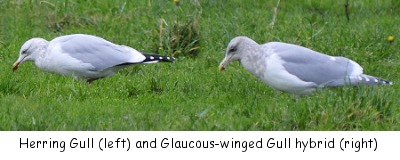
This species is probably the second-most common large gull here. This gull has a similarly coloured grey back compared to the Glaucous-winged Gull, but has black wingtips and displays a yellow eye when viewed closely. Herring Gulls usually seem slightly smaller and are not as chunky as a Glaucous-winged gull hybrid. Also, the streaks on a Herring Gull's head and neck in winter plumage tend to be more crisp. A Glaucous-winged Gull has smudgy streaks on its head and neck. This trait can be seen in its hybrids as well which more often than not, have smudgy streaks.

Thayer's Gull
A Thayer's Gull is smaller and petit looking 'large' gull. A rounded head, dark eyed gull with a short bill often stands out among the larger and more bulky gulls. Wingtips are black or very dark grey on a folded wing but when in flight, the black is rather sparse; especially on the under wing and can seem to be more of a dark grey. Herring Gulls typically have much more black in their wingtips when viewed in flight. Often extensivly streaked on head and neck during the winter.
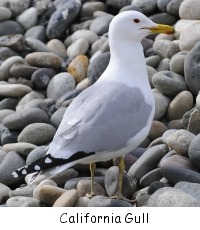
California Gull
California Gulls are mostly encountered in the spring and fall as they migrate through the area. They are uncommon in the winter. On the smaller end of the large gull group; around the size of a Thayer's Gull. Black wingtips are extensively black when seen in flight. The only yellow-legged large gull described here (all of those others have pink legs), but this is not terribly useful when the gull is in grass that covers its legs. Dark eyed with a little strip of black along with the red spot on the bill. Their backs are slightly darker than the other gulls, excluding Western and Glaucous-winged Gull hybrids, as described so far
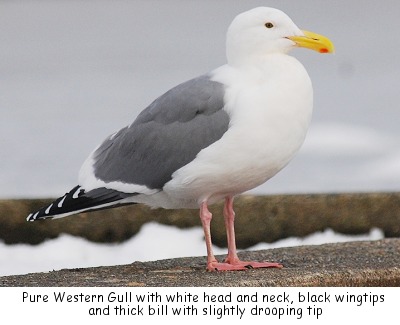
Western Gull
Rare but seen regularly in the area. Due to hybridization, many are not pure birds. Watch for quite dark grey backs and solid black wingtips. In flight, the wingtips are extensively black. The head and neck of a pure Western Gull should be very white. Too much in the way of any streaks on the head or neck suggests a hybrid (so essentially, is neither one species nor the other). The bill tends to be heavy and thick-tipped.
Final Notes
1). Learn common species first and focus on the obvious examples. Adult gulls should also be your main focus at first.
2). Adult gulls are in winter colours from fall through winter. In the spring, their heads will start to turn white.
3). As noted previously, don't expect to find more than three or four Thayer's and/or Herring Gulls in a big flock of gulls. If you think you've seen 20 Herring Gulls in a field of gulls, it might be time to take a closer look.
4). Hybrid gulls are able to breed and their offspring are an interesting mix between the hybrid and the other parent species (which could also be a hybrid!)
5). Size varies to a certain extent, especially among male and female. A male can be larger with a heavier, longer bill over a female of the same species. Thus, a small female Glaucous-winged Gull hybrid could appear as a male Thayer's Gull for example.
6). A spotting scope is very useful for gulling adventures. If you don't have one, try to find gulls that can be viewed fairly close. Trying to learn on gulls that are too far away for a good look is frustrating. Sardis Pond and Salish Pond are both excellent places to see gulls up close as they prowl for handouts. .
7). Finally, some gulls are not meant to be identified positively. Do what you can with them then move on. Don't stare at them for too long. It might not be healthy!!
A series of photos that would not fit in the article above concludes this article. Happy gulling!

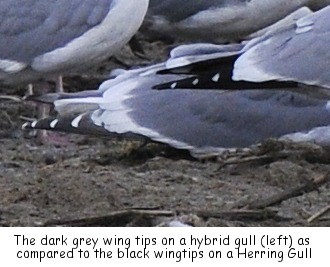
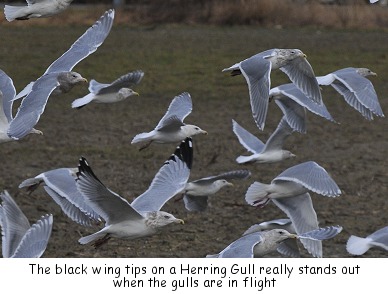
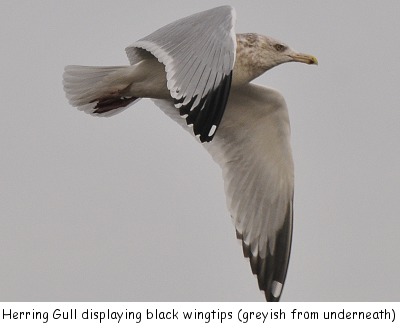
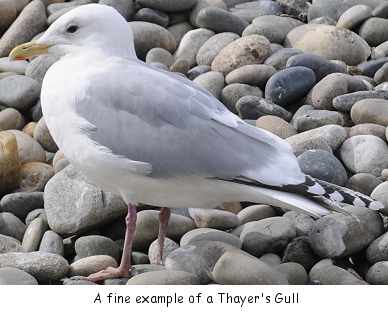

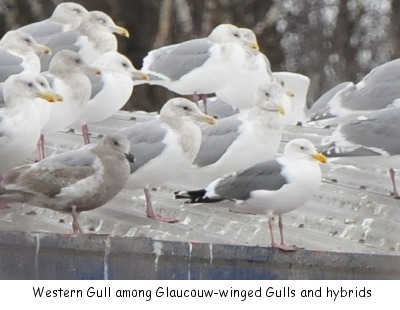
|